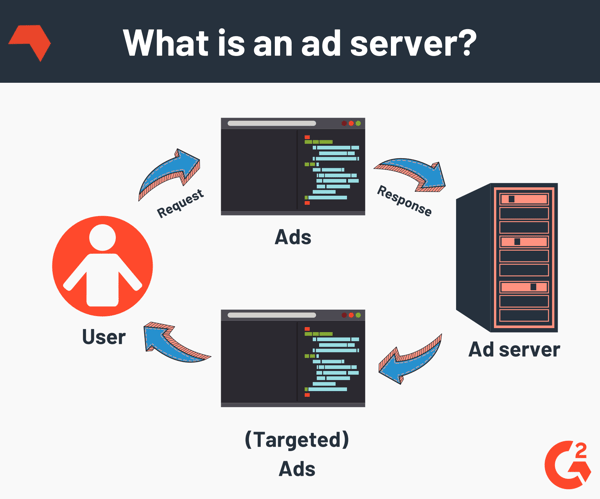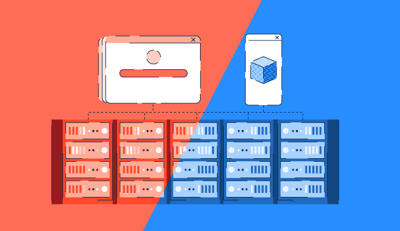

Not long ago, the process of advertising looked completely different.
To get your campaigns running, you had to negotiate the price and placement of ads with the publisher, decide on targeting and other important parameters, sign the IO, and then wait about a month for the first results – which you needed to optimize manually.
The whole process of negotiation took approximately 20-45 days. The first ad server ever created was able to host and serve hundreds of ads and allowed a person to manage and optimize all advertising activities. At this point, launching ad campaigns took as few as two days.
This article will explain everything you need to know about ad servers while also helping you understand how they can help advertisers, publishers, and ad networks manage all types of advertising.
An ad server is the technology that places advertisements on websites while tracking and customizing said ads.
Ad server software was created because advertisers and publishers needed a system for storing ads and creatives while tracking their effectiveness.
In short, the ad server is a SaaS solution which serves, tracks, and customizes multi-screen ads. It usually supports a vast variety of ad formats, including desktop, rich-media, in-app, pops, mobile web, and video all in the same account.
When ad servers distribute ads to various publishers, they use ad tags or HTML codes that refer to their systems with the request of content.

To most practitioners, the ad serving process can still be a bit unclear. This is why it’s extremely important to thoroughly explain how it works and exactly how it can help publishers, ad networks, and advertisers. The whole ad serving process takes less than a second:
An ad server can help all participants of the online advertising ecosystem reach their goals. For publishers, the ad server helps to better monetize their inventory. For advertisers, it’s an efficient user acquisition tool with easy management of cross-channel advertising activities.
For publishers, an ad server is the first thing to consider if they want to show ads on their websites. It offers the technology to connect to hundreds of advertisers all in one ad serving account. If a publisher wants to add 10 demand partners, all they need to do is set up their ads on the ad server and turn them into a single code, which rotates the ads.
They then add the code on the website layout to get the wheels rolling. With the extensive targeting that the ad server offers, you can be sure that the website user will see only the targeted ad which is based on the multiple predefined parameters.
By controlling users’ interactions with ads, publishers get a chance to optimize ad placements and run the best-performing ads on different spots.Ad servers help publishers keep track of ad performance and revenue. A decent ad server offers not only extensive targeting options, but also pacing and frequency cap as well as more to help you maximize the outcome from every impression.
Advertisers and media buyers use ad servers to maintain control over their online advertising activities. Ad servers are necessary to:
| TIP: Learn the 5 top benefits ad servers provide to advertisers. |
Before testing out the ad server, you need to define your advertising goals. Besides just serving ads, there are several other features you may utilize the ad server for.
With the ad server, you can control ad creatives and run A/B testing experiments with ease. The ad server technology helps to conduct these tests with just a few clicks. Moreover, most ad servers have an automatic optimization feature, which helps to reduce manual work while achieving higher ad performance.
With the help of the ad server, you can control and customize everything in your account according to your business goals. Create reports with the important metrics, and get scheduled reports about your ad performance.
In the current advertising reality, the extensive targeting features became mandatory. Take a closer look at the ad servers which offer behavioral targeting and retargeting software features, (e.g. Epom Ad Server, MediaMath, Revive).
As mentioned before, when using the ad server, you are constantly dealing with ad tags. Ad tags are redirects to content rather than the content itself. They are quick to implement and accepted by every part of the online advertising system.
However, with ad tags, your final traffic sources cannot always be clearly defined. When buying traffic in bulk from a certain ad network, you still may not know where it gets its traffic from.
Nowadays, the demand side platform is considered to be the next step in the online advertising evolution: instead of putting ads anywhere, DSPs decide which impressions are the most valuable to your campaign.
Demand Side Platforms (DSPs) are software platforms used to buy traffic programmatically across multiple ad exchanges. DSP works on an RTB basis. With RTB technology, there's no need to negotiate prices with the publishers, as all of this is done automatically.
The DSP automates media buying across many supply-side partners, allowing you to buy an audience rather than just "traffic". With a DSP, you can set a different price for any specific audience and be sure you'll get exactly what you've paid for. The real-time auctions eliminate human interference and provide equitable traffic distribution.
To media buyers, it means there is no longer "premium traffic" that goes to those who pay more; instead, the DSP can see the actual price and not overpay for it.
Programmatic advertising and media buying via a DSP has a significant advantage over the standard tags:
DSPs can be used to broaden the ad network spectrum of expertise and add a powerful advantage to its services over the competitors. The development of your own DSP can cost thousands of dollars, and here’s why some companies decide to use White Label DSPs (like Epom WL DSP, Targetoo, Bidsopt). White labeling in its core means adjusting the interface, logo, buttons, and all elements so it resembles the style of your company.
The ad server stores and distributes ads to the right users and reports its performance in real time. If you are a publisher, you need an ad server to serve and manage multiple cross-channel ad campaigns from one account.
You need a DSP when you operate with decent traffic volumes and want total control over bidding and campaign management, all while tracking the best possible advertising opportunities within one platform.
Interested in learning more? Check out our guide on the differences between web and application servers!
Anna is the CMO at Epom, a SaaS ad server and management platform for ad network businesses.
In the world of advertising, ad-buying is just part of the job.
 by Lina Lugova
by Lina Lugova
Servers handle the requests your browser makes while you’re online. Two types of servers...
 by Sagar Joshi
by Sagar Joshi
Your organization’s digital offering - its software interfaces, websites, and applications -...
 by Priya Khaira-Hanks
by Priya Khaira-Hanks
In the world of advertising, ad-buying is just part of the job.
 by Lina Lugova
by Lina Lugova
Servers handle the requests your browser makes while you’re online. Two types of servers...
 by Sagar Joshi
by Sagar Joshi
Never miss a post.
Subscribe to keep your fingers on the tech pulse.



